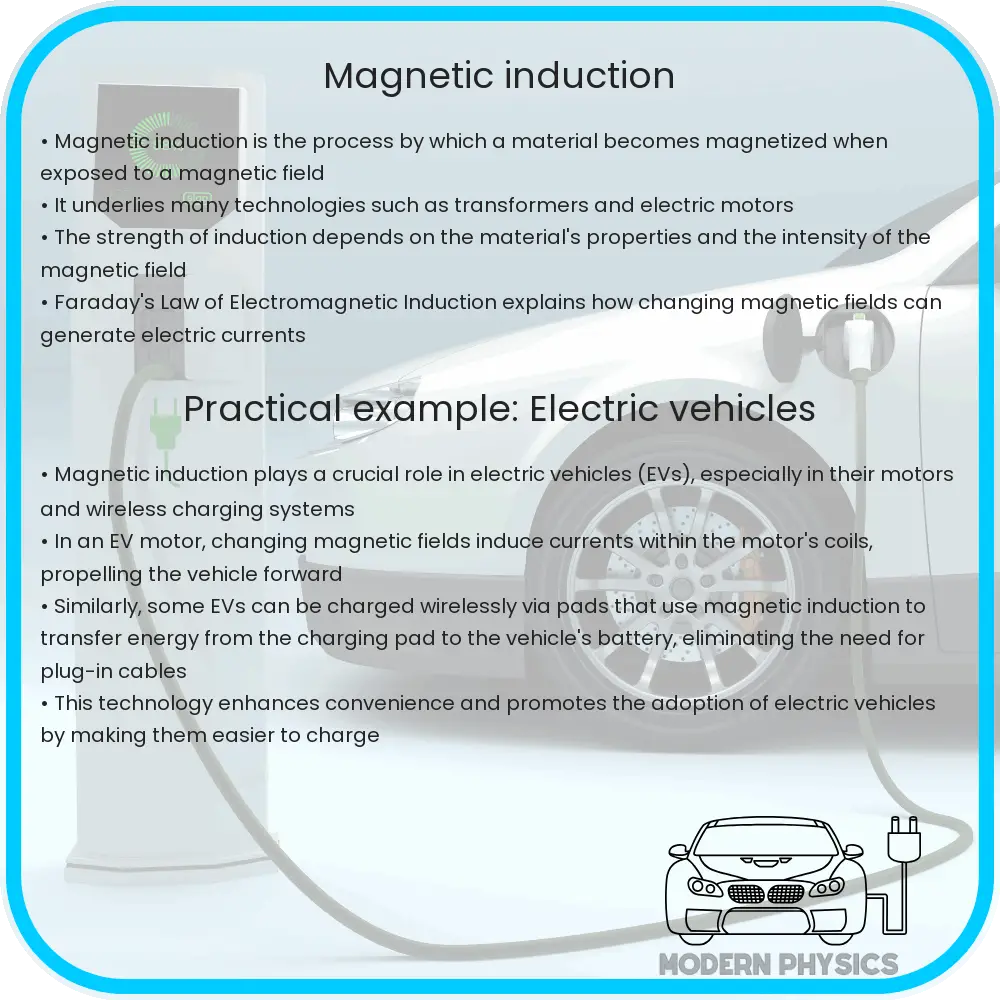Explore magnetic induction’s principles, efficiency, and diverse applications in technology and medicine, and its future prospects in physics.

Magnetic Induction: Unraveling the Phenomenon
Magnetic induction, a fundamental concept in physics, plays a crucial role in modern technology. It refers to the process by which a magnetic field induces a voltage in a conductor. This phenomenon is governed by Faraday’s Law of Electromagnetic Induction, which states that the induced electromotive force (EMF) in any closed circuit is equal to the rate of change of the magnetic flux through the circuit.
At the heart of magnetic induction is the magnetic field, represented by the symbol \( B \). When a conductor, such as a coil of wire, is placed in a changing magnetic field, an EMF is induced in the conductor. The magnitude of this induced EMF can be calculated using the formula:
\[ \text{EMF} = -N \frac{d\Phi_{B}}{dt} \]
where \( N \) is the number of turns in the coil, and \( \frac{d\Phi_{B}}{dt} \) represents the rate of change of the magnetic flux \( \Phi_{B} \) through one loop of the coil.
Efficiency of Magnetic Induction
The efficiency of magnetic induction processes is a key factor in their practical applications. Efficiency refers to the ratio of the useful output (in this case, the induced EMF or current) to the input energy. In ideal conditions, this efficiency can be high, but in real-world applications, several factors such as resistive losses in the conductor and eddy currents can reduce efficiency. Minimizing these losses is crucial in designing efficient electromagnetic devices.
Applications of Magnetic Induction
Magnetic induction finds applications in various fields, from everyday appliances to advanced scientific instruments. Some notable applications include:
- Electric Generators: These devices convert mechanical energy into electrical energy using magnetic induction. They are fundamental in power generation, from small portable units to large-scale power plants.
- Transformers: Widely used in power distribution, transformers operate on the principle of magnetic induction to change voltage levels, thereby facilitating efficient power transmission over long distances.
Continuing with more applications, magnetic induction also plays a pivotal role in…
- Inductive Charging: This technology uses magnetic induction to wirelessly charge devices, such as smartphones and electric toothbrushes, enhancing convenience and reducing the need for cables.
- Magnetic Resonance Imaging (MRI): In healthcare, MRI machines use magnetic induction to generate detailed images of the body’s internal structures, aiding in diagnosis and treatment planning.
- Induction Motors: These motors are essential in various industries for their efficiency and reliability. They operate on magnetic induction principles, converting electrical energy into mechanical motion.
Further, magnetic induction is instrumental in scientific research, particularly in the study of electromagnetic properties and materials science. Advanced experiments often rely on inductive methods to measure magnetic fields and properties of materials at the atomic level.
Challenges and Future Prospects
Despite its widespread application, challenges remain in the field of magnetic induction. These include improving the efficiency of inductive devices, especially in power generation and transmission. Research is ongoing to develop materials with better magnetic properties and to design more efficient induction systems.
The future of magnetic induction looks promising, with potential advancements in wireless power transfer, which could revolutionize how we use and transmit energy. Innovations in superconducting materials could lead to more efficient power grids and transportation systems. Moreover, the evolving field of spintronics, which exploits the magnetic spin of electrons, promises to open new frontiers in data storage and quantum computing.
Conclusion
Magnetic induction is a cornerstone of modern physics with a profound impact on technology and daily life. Its principles are integral to a wide array of applications, from generating electricity to medical imaging. While challenges exist in enhancing efficiency and developing new technologies, the prospects for innovation and advancement in this field are vast. As we continue to explore and harness the potential of magnetic induction, its role in shaping future technological advancements remains pivotal.
